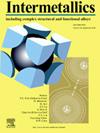通过直接粉末锻造制造的粉末状铁铝化物 Fe - 28Al 的机械性能
IF 4.3
2区 材料科学
Q2 CHEMISTRY, PHYSICAL
引用次数: 0
摘要
本研究探讨了粉末直接锻造对铝铁合金 Fe-28 的成分、结构和机械性能的影响。在合成和锻造 Fe3Al 粉末的过程中,在 1100 °C 的温度下形成了均匀的 A2 相。锻造后的孔隙率为 2-2.5%。残留孔隙主要呈平面状,位于粉末颗粒的边界。1300 °C退火可改善颗粒间边界的质量,所有样品都表现出跨晶断裂机制。在 1100 °C 下锻造并在 1300 °C 下退火的样品显示出最大强度 σbend = 1050 MPa 和断裂韧性 K1c = 32.3 MPa-m1/2。屈服强度显示出异常的温度敏感性,在 400 °C 和 500 °C 时达到最大值。在 600 °C 下测试的样品屈服强度有所下降,但足够高的屈服点 σy ∼400 MPa 和高强化率对高温抗蠕变性非常重要。在 600 °C、载荷为 120 兆帕的蠕变实验中,应变速率的变化范围为 10-7-10-6 s-1,速率灵敏度 n ≈ 4。蠕变的主要机制是位错滑行。本文章由计算机程序翻译,如有差异,请以英文原文为准。

Mechanical behavior of powdered iron aluminide Fe – 28Al manufactured by direct powder forging
This study examines the impact of direct powder forging of powders on the composition, structure, and mechanical properties of iron aluminide Fe–28 at. % Al. During the synthesis and forging of Fe3Al powders, a homogeneous A2 phase is formed at a temperature of 1100 °C. Porosity after forging is 2–2.5 %. Residual pores are predominantly planar in shape and are located at the boundaries of the powder particles. Annealing at 1300 °C improves the quality of interparticle boundaries and all samples exhibit transcrystalline fracture mechanism. Samples forged at 1100 °C and annealed at 1300 °C show maximum strength σbend = 1050 MPa and fracture toughness K1c = 32.3 MPa·m1/2. The yield strength demonstrates anomalous temperature sensitivity with a maximum of 400 °C and at 500 °C. Samples tested at 600 °C show a decrease in yield strength, but a high enough yield point σy ∼400 MPa and a high strengthening rate are very important for high-temperature creep resistance. In creep experiments at a load of 120 MPa at 600 °C, the strain rate varies in the range of 10−7–10−6 s−1, the value of the rate sensitivity n ≈ 4. The main mechanism of creep is dislocation glide.
求助全文
通过发布文献求助,成功后即可免费获取论文全文。
去求助
来源期刊

Intermetallics
工程技术-材料科学:综合
CiteScore
7.80
自引率
9.10%
发文量
291
审稿时长
37 days
期刊介绍:
This journal is a platform for publishing innovative research and overviews for advancing our understanding of the structure, property, and functionality of complex metallic alloys, including intermetallics, metallic glasses, and high entropy alloys.
The journal reports the science and engineering of metallic materials in the following aspects:
Theories and experiments which address the relationship between property and structure in all length scales.
Physical modeling and numerical simulations which provide a comprehensive understanding of experimental observations.
Stimulated methodologies to characterize the structure and chemistry of materials that correlate the properties.
Technological applications resulting from the understanding of property-structure relationship in materials.
Novel and cutting-edge results warranting rapid communication.
The journal also publishes special issues on selected topics and overviews by invitation only.
 求助内容:
求助内容: 应助结果提醒方式:
应助结果提醒方式:


